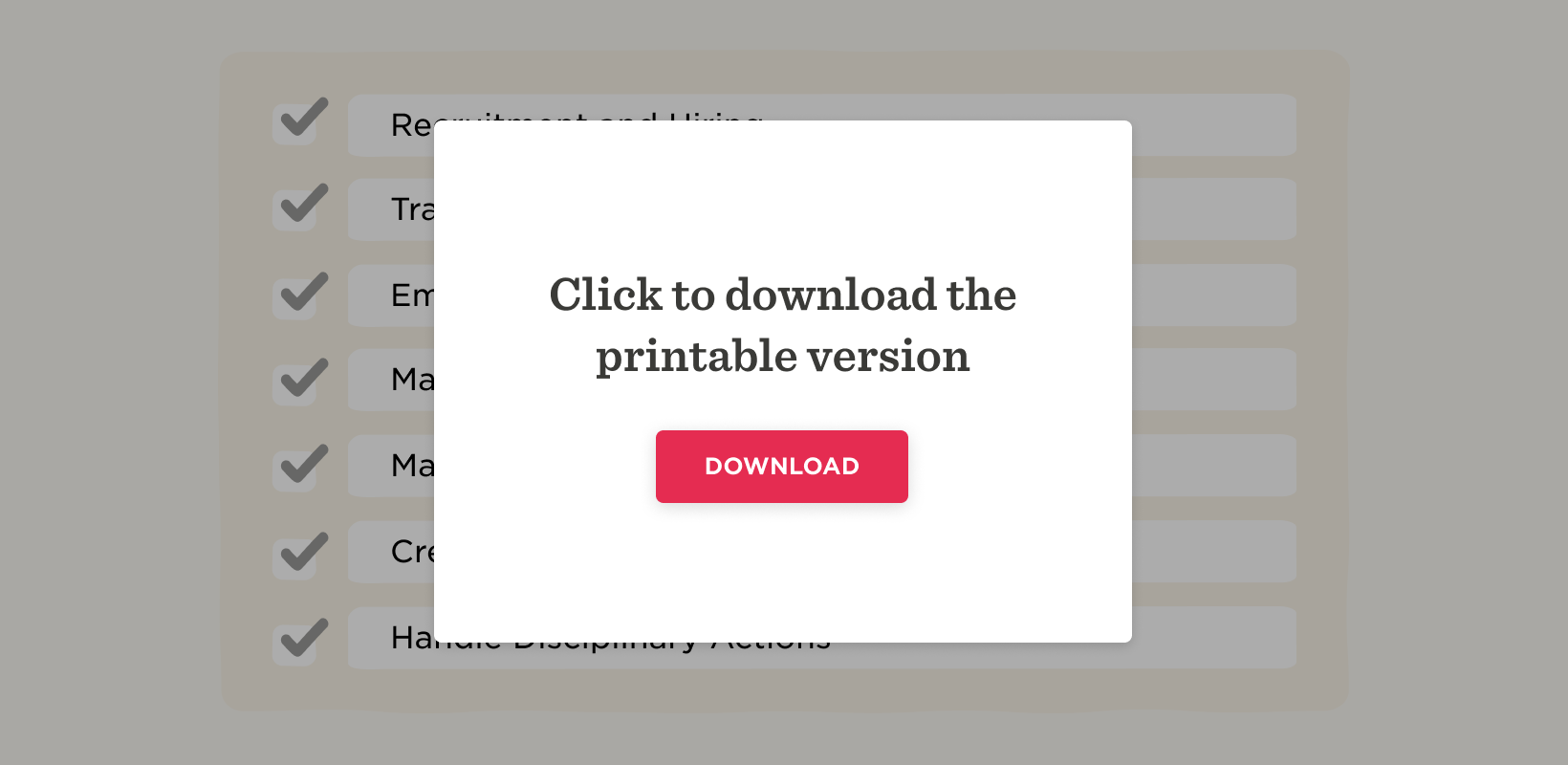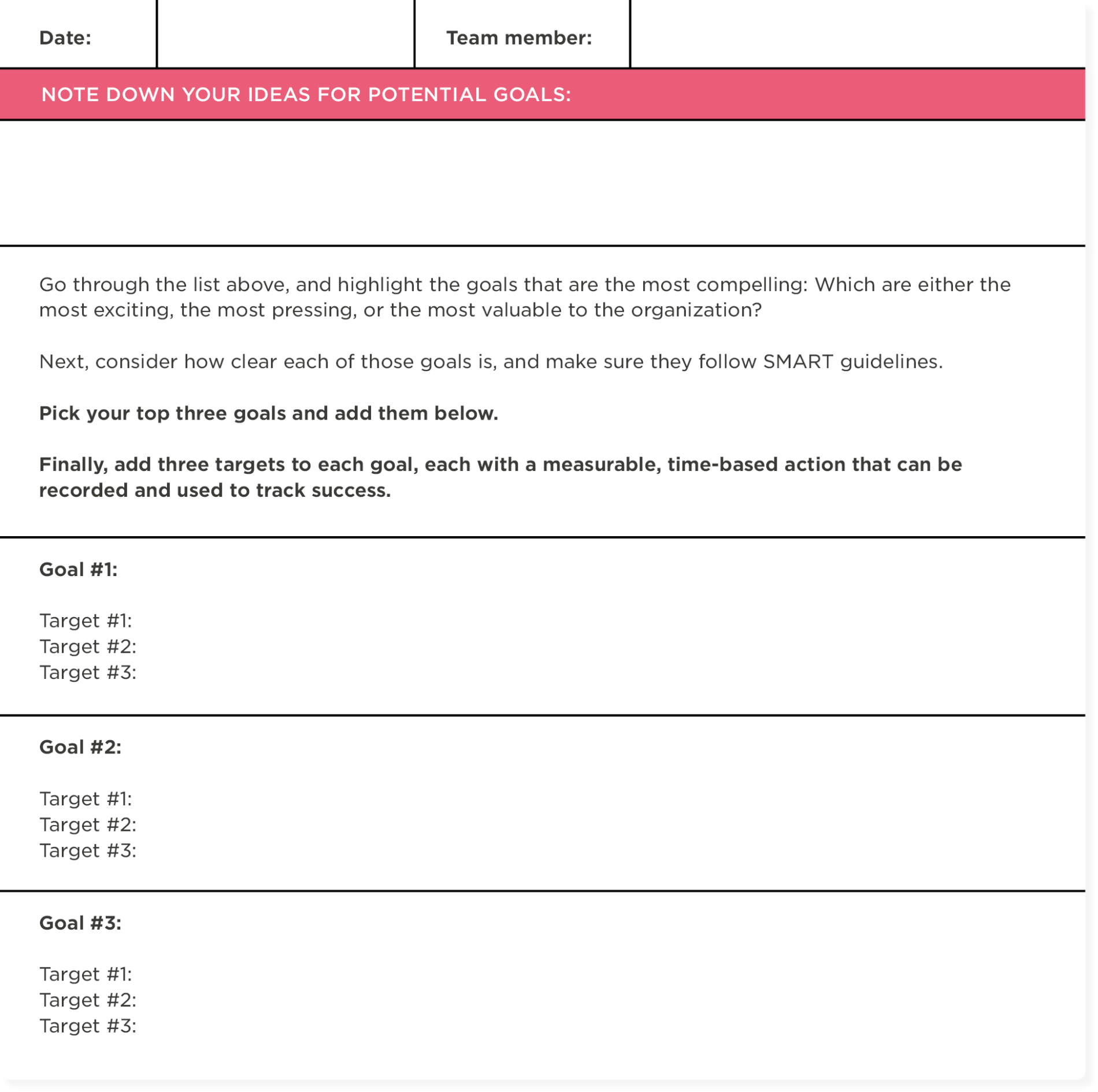How do you measure success?
For the business as a whole, it’s likely to relate to financial or growth targets, market performance, or internal metrics.
At the individual level, however, it can be harder to measure success without clearly established goals and objectives.
Both at the day-to-day and strategic level, tracking and identifying performance is an essential part of running a successful business. Setting clear goals doesn’t just help you measure individual and organizational successes. It also contributes to individuals’ sense of motivation, sense of purpose, and drive.
Crucially, goal setting is also a powerful way of aligning individual workloads with your organization’s wider mission, making sure that your teams are pulling in the same direction.
As a result, getting your goal setting right can make a huge contribution to your business’s success and the development of the talented individuals within your teams. Keeping them engaged, productive, and effective plays a big part in laying the foundation for future success.
So, how do you go about setting HR goals, and how do these interact with your wider strategic objectives?
In this guide, we’re going to take you through how employee performance metrics can support effective goal setting, both as part of a performance management drive as well as day-to-day. We’ll also work through an employee goal setting template to get you started.

The importance of employee goal setting
Setting goals for your people is crucial for fostering a work environment focused on performance improvement and for ensuring that individuals’ work aligns with your company’s overarching objectives.
At an individual level, goals provide professionals with a clear roadmap for their work. Goals help them understand exactly what is expected of them, helping them channel their efforts in a productive, useful direction. By clarifying expectations in this way, you can help to prevent confusion, misdirection, and wasted work.
Similarly, individual goals can play a significant role in increasing the motivation of your people. With specific targets to aim for—and a strong sense of satisfaction when those goals are met—team members will feel more engaged and happier at work, and therefore are likely to be more productive and resilient in their roles.
Goal setting is also important for introducing a sense of accountability. Targets help people feel responsible for their work outcomes, which can increase performance. A clear, structured feedback process based on goal setting supports constructive discussions that help people and managers identify areas for growth and improvement. As people work to achieve their goals, they acquire new skills and knowledge that contribute to their professional growth, and that of your company.
At an organizational level, setting goals improves your strategic coherence. With clear evaluation, managers can accurately track the progress of their teams by comparing performance against tangible goals, helping them to identify areas for improvement and growth. That in turn allows you to allocate resources and budget across and within teams.
Goal setting also allows you to align those team aims with your broader strategy, helping to keep everyone working together in the same direction, driving to achieve the company’s mission. This can improve collaboration across your organization, strengthening your collective momentum.
Without setting goals, it’s easy for individuals and organizations to fall into the same habits and traps and for your effectiveness to be hamstrung by repetition and blind alleys.
<< Download and print this template to elevate your team’s performance >>
An example of an employee goal setting template
Although it’s important to set clear goals for your people, getting started can be difficult.
That’s why we’ve put together this goal setting template to help you and your managers define clear, achievable goals that can help improve the efficiency and productivity of your entire organization.
Adapt it to your needs, whether that’s a performance improvement plan template or an employee development plan template.

<< Download and print this template to elevate your team’s performance >>
Examples of employee goals
Professional goals come in all shapes and sizes. Depending on your industry and the different roles within your organization, it’s important to create individualized, specific targets.
It’s best to consider two aspects to each goal: the driving purpose or objective, and the measurable targets that you’ll use to measure success.
In each of these examples, it’s clear to see how the targets could inspire tangible actions and choices, motivating individuals and helping your organization achieve its wider strategic ambitions.
Here are some common examples:
Performance goal example
Objective: Improving interest in our website so that it generates more leads
Target #1: A 10-percent increase in website traffic in the next 12 months
Target #2: A two-fold increase in dwell time
Target #3: Monthly MQLs from the website up by 15 percent
Personal development goal example
Objective: Developing an enhanced knowledge of coding languages to support day-to-day work and give the team a new skill
Target #1: A working knowledge of SQL by December
Target #2: Knowledge sharing with the team where this can help improve workflows
Target #3: A brief report of which other languages may prove useful in the future
Team collaboration goal example
Objective: Improving team communication and collaboration, building trust and more efficient working practices
Target #1: Monthly one-on-one chats between team members so they can learn more about each other
Target #2: Quarterly team-building exercises to explore communication and collaboration styles
Target #3: An open feedback thread for suggested ways to improve team collaboration
Time management goal example
Objective: Improving time management to reduce stress and give other team members longer lead times for their work
Target #1: Experimenting with various tools, such as the Pomodoro Technique and the Eisenhower Matrix, and use of a task management system
Target #2: Time tracking of work to capture changes in performance and ability to reduce time spent on non-essential tasks
Target #3: Monthly reviews with line manager to assess impact and work prioritization
Diversity and inclusion goal example
Objective: Promoting diversity and inclusion within the workplace, across teams
Target #1: Organize and lead diversity training sessions for everyone
Target #2: Increase diversity in the hiring process by ensuring diverse candidate pools for open positions
Target #3: Establish an employee resource group to support underrepresented staff and foster inclusivity
Cost reduction goal example
Objective: Reducing operational costs to improve company profitability
Target #1: Identify and implement cost-saving measures to reduce annual operating expenses by 10 percent
Target #2: Optimize supply chain management to reduce inventory carrying costs
Target #3: Reduce energy consumption and environmental impact by 15 percent through promoting more sustainable practices across the organization
Customer service goal example
Objective: Enhancing customer service quality and satisfaction
Target #1: Decrease average customer response time on live chat to an average of less than five minutes
Target #2: Achieve a customer satisfaction rating of 95 percent or higher in post-interaction surveys
Target #3: Implement a customer feedback system and address 100 percent of customer feedback within 48 hours
Leadership development goal example
Objective: Improving leadership skills to progress into a managerial role in the future
Target #1: Complete a leadership training program to develop decision-making and team management skills
Target #2: Mentor a junior team member to improve coaching and leadership abilities
Target #3: Spend an hour each month with senior colleagues to develop leadership skills and learn from their experiences

How to effectively set goals for employees
Establishing the right goals for your people is only half of the battle. How you go about creating those goals—especially when they relate to someone’s performance—can be a sensitive and tricky process.
So how do you follow best practice?
- Establish clear goal-setting criteria. When managers and team members go about creating goals, it’s important that they have a clear idea of which criteria their goals should meet. You might choose to have a specific “house style,” or there may be a fixed number of measurable targets you’d like each goal to have. It’s also useful to make sure each goal is SMART: Specific, Measurable, Achievable, Relevant, and Time-Bound.
- Make sure individual goals align with organization-wide objectives. Work with managers to ensure that they clearly understand your wider strategic goals. That way, they can guide individual goals to effectively tie in with your company’s purpose.
- Encourage people to set realistic yet challenging goals. Effective goal setting is all about balance, finding the middle point between overambitious goals that will never realistically be achieved and underambitious goals that don’t generate sufficient growth.
- Set up a process to track goals. This can include regular feedback and check-in sessions with line managers, as well as self-assessed progress reports. Frequent communication is particularly essential for any personal performance-related goals.
- Allow space for adjustments. In business as in life, things can change—sometimes at short notice—so make sure you have a clear process for adjusting and adapting goals as required.
- Empower your people. Finally, it’s important to give people autonomy and ownership over their own goals, targets, and achievements. Make sure to allocate sufficient resources (both in time and money) to their continued progression and professional development, so that they can contribute to the long-term success of your business.
Recommended For Further Reading
Goal setting for employee performance
There are a few key principles to keep in mind when setting goals that relate to the performance of your people in order to make sure these drive improvement and growth:
- If in doubt, communicate. Poor communication is at the heart of many relationship breakdowns. Given that performance can be a sensitive issue, it’s even more essential to provide regular touchpoints and ways for team members to discuss their progress.
- Keep it specific and professional. When discussing any improvements you’d like to see, it’s important to use specific examples and to provide targeted, tangible goals.
- Provide recognition for accomplishments. Goal setting works best when people feel motivated to achieve their targets. Celebrate those achievements when they hit key milestones, demonstrate outstanding performance, or work hard to adapt and grow.
Ready, set, go!
Setting goals for your people is an essential element in constructing teams that are motivated to work together toward common organizational objectives. These goals will help your people feel inspired and empowered at work and to continue to develop their professional skills.
As you establish or enhance your business’s goal setting process, it’s important to consider how to create consistency between teams alongside the flexibility that gives people ownership over their own progression. By communicating with managers and senior leadership, you can make sure that individual goals link clearly through to your wider mission.
With clear goals, regular feedback, and the space to celebrate achievements, you can build a more effective, efficient, and inspired workforce.
